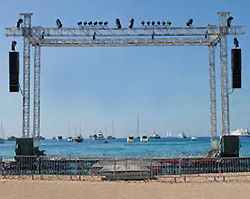I began writing this series of rigging safety articles several months ago motivated by the many dangerous practices I’ve seen over the years. (See part 1 and part 2.)
These disasters-waiting- to-happen lurk in clubs, small shows, medium shows, and sizeable temporary events.
This past summer, we have witnessed staging/rigging tragedies in Canada, Indiana, and Belgium. The common element in each of these truly unfortunate incidents are media reports of extreme weather conditions. There’s a very human tendency to believe these “acts of nature” are unavoidable, and in some respects, it’s true.
But those who promote outdoor shows, and those who stage them, have an implicit responsibility to both closely monitor worst-case weather patterns and to have decisive, immediate, and safe plans of action to do everything possible to keep everyone safe.
Further, the reality of a sudden storm – versus a slow onset – has become all too well-known in recent weeks, but regardless, the stage and all associated structures must be designed and built to withstand the worst that nature has been known to deal out in the past, plus a margin of headroom. Must be. Anything less is a gamble; a misguided dice roll that risks other people’s lives and well being.
A suggestion: if an event is held in an area known for weather conditions that cannot be mitigated by strength-of-build, such as violent storm squalls or tornados capable of leveling permanent construction, then further precautions must be undertaken. For example, spotters could be deployed a mile or two out, watching the skies and able to radio in warnings in time to get everyone off the stage and away from the towers.
At the least, a competent individual should be assigned to monitor all available weather reports. He /she must have the authority, and the clarity of purpose, to stop the show at the first sign of trouble. A false alarm or two is far better than waiting until it’s too late.
In addition, fall zones should be established around the stage, and any support towers and cordoned off, so that in the event of structural failure, no one will be in the danger zone when the structure collapses.
Safety guy wires (wires that run from ground anchors to the top of the stage structure) can greatly help to stabilize a structure when it’s subjected to wind load – and even seismic loading – though they also produce a vector force of their own pulling outwards and downwards: the structure therefore must be strong enough to handle the added load of the safety wires.
Safety wires represent a lot of extra work and expense – but nowhere near the cost of a single human life. It’s also possible to add extra tension to the stabilizing wires in the rear so that if the structure does fail, it will topple rearwards, away from audience members, rather than forwards and towards them.
Further Steps
Load cells – small devices that provide tensile information electronically to a remote readout – are relatively inexpensive these days. They can be built into the stabilizing wires and into other key load points of a stage, or a sound tower or lighting tower. The increasing force from a freshening storm can be monitored electronically from a safe distance.
A rapid-deployment retractable roof system can be readily designed to remove the wind load on the huge fabric surface in seconds, in the event of a storm that sneaks up suddenly. Using the same mechanical arrangement as a ball-bearing sail track on a sailboat, and a few electric cable-spools, a roof could be retracted in seconds.
Sure, the equipment on stage is going to get wet. That’s O.K. if lives are saved. (And anyway, that’s what tarps are for.) There’s likely to be plenty of time to deploy tarpaulins, but only after the threat of the roof collapsing has been reduced by removing the roof “sail” area.















